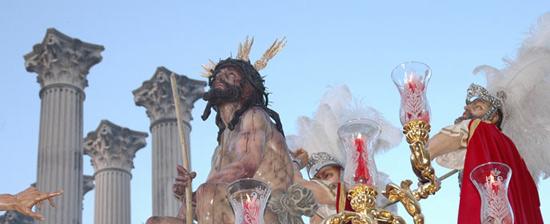Mags Gargan finds the celebration of Holy Week in Spain, has something to offer all the senses
Spending Semana Santa (Holy Week) in Andalucia, a region in Southern Spain, is a true feast for all the senses, as communities gather to continue a centuries-old tradition of devotion.
From small towns to major cities, the streets of Andalucia are transformed into a form of religious theatre by local brotherhoods and confraternities, where processions of elaborately decorated floats with statues of Jesus depicting his last days or of a mourning Virgin Mary surrounded by flowers are led by hundreds of pointy-hood wearing Nazarenos (penitents) carrying candles and burning incense, all followed by brass bands or drummers, walk slowly through the streets from their parish church to the cathedral and back.
Dating back to the 16th Century, the processions began as a way to present the story of the Passion of Christ in a way that uneducated laypeople could understand. The pointed-hat costumes of the Nazarenos can seem sinister for first-time observers, because although they come in different colours and styles according to each brotherhood, the pointed hoods (capirotes) do resemble those worn by the Ku Klux Klan.
However, the Spanish tradition far predates the KKK and is a sign of humility, penance and mourning. On Easter Sunday, each person removes his capirote in jubilation at Jesus’ resurrection from the dead.
Floats
The men, and now increasingly also women, who carry the floats can spend hours in procession shouldering these heavy burdens (approx. 40 kilos per person) in very hot conditions, with their faces often covered by the hoods and some of them complete the procession barefoot. It is a huge challenge of resilience to endure the pain, discomfort and heat, not to mention the smell of sweat! The precise step of their feet beneath these enormous floats, practised for weeks beforehand, is also an example of team work and friendship, which translates into their daily lives the rest of the year as members of brotherhoods and confraternities.
Many penitents make the gruelling journey each year for reasons of honour and family tradition, some say they do it as penance or as a ‘promise’, in the name of a loved one who is struggling or suffering, and for most it remains a religious ritual.
Seville, Granada and Malaga are the major towns of Andalucia and would usually be the first option for visitors wanting to experience this unique celebration of Holy Week. However, the smaller towns of the region have come together to form ‘Caminos de Pasion’ as a way of promoting the distinctive characteristics they have to offer, in a less crowded and more accessible way that is no less atmospheric.
Every year Alcalá la Real, Baena, Cabra, Carmona, Lucena, Osuna, Priego de Córdoba and Puente Genial are transformed into magnificent settings for their own unique celebration of community, tradition and faith, handed down from one generation to the next.
Rhythm
In Baena, for example, the rhythm of Holy Week is marked by the sound of drumming rising up from the turbas de judíos (mobs of Jews) divided into two groups: coliblancos and colinegros (whitetails and blacktails).
These unmistakeable figures wear embroidered red jackets, neck scarves and metal helmets with plumes and long tails of white or black horse hair. They represent the crowds who condemned Christ and their role is to accompany the processions, beating their handmade goatskin drums and taking part in some of the popular dramatisations performed during the processions.
They start roaming the winding streets of the town in small groups beating their drums from the early hours and throughout the day.
Cabra, Carmona, Osuna and Priego de Córdoba are famous for their extraordinary Baroque religious images, Gothic sculptures and artistic floats. Carmona is home to the oldest carved image still taken out in procession, el Cristo de la Amargura (Christ of Grief) from 1521 and also Neustro Padre Jesús Nazareno (Our Father Jesus the Nazarene) from 1607 is the earliest known iconographical model for this type of Christ figure.
For me, watching the brotherhoods of Carmona carefully carry their huge floats through the large gates in the town walls was a particularly spectacular sight in the fading dusk light.
Theatrical re-enactments of scenes from the Old and New Testament by members of the local brotherhoods in costumes with large masks and wigs are unique to Alcalá la Real and Puente Genil, while Lucena is known for its stirring processions where the penitents march to a hypnotising drum beat and a unique bugle call.
Blessing
In Lucena, I watched the Cofradía del Nazareno (Brotherhood of Jesus the Nazerene) carry the figure of Christ on his way to Calvary, stopping three times along the route to allow the statue to bestow his blessing with the movement of a mechanical hand and to shouts from the large crowd of “Viva!” This float is a 50 kg weight for each man, the heaviest that I saw during Semana Santa. The men wore tunics and hoods, but their faces were uncovered so I could see the strain of the weight in their expressions and the sweat dripping down their necks.
During Holy Week the streets of these pretty, white-walled towns come alive with colour and sound, and it is difficult not to be moved by the slow rhythmic beat of the processional marches, the swaying pace of the determined bearers carrying the floats and the poignant singing of the ‘saeta’ (a form of singing sacred song in an almost Sean Nós style), which brings a tear to many eyes.
The celebrations are true community events with thousands lining the streets each year, dressed up in their Sunday best, explaining the proceedings to their children and gathering for a family meal afterwards.
Although the links between the processions and the official Holy Week celebrations of the Church have become tenuous, and for an increasing number it is now more of a cultural tradition than a religious devotion, participants and spectators do experience emotional and spiritual nourishment that they struggle to articulate in words.
Beyond the attractions of Holy Week the eight towns in the Caminos de Pasion also epitomise the heritage at the heart of Andalucia and the legacy of the region’s Moorish and Baroque past. There are many convents, cathedrals and castles to visit and explore.
You could also taste the region’s unique cuisine, which is famous for its extra virgin olive oil, wines, convent-produced traditional confectionery, quince jelly, cured meats and cheeses.
Now that Lent has begun, this is the perfect time to plan a unique way to commemorate the sadness of the Passion and the joyful celebration of the Resurrection, through the Semana Santa traditions of Southern Spain.


 Mags Gargan
Mags Gargan Holy week in Spain
Holy week in Spain 